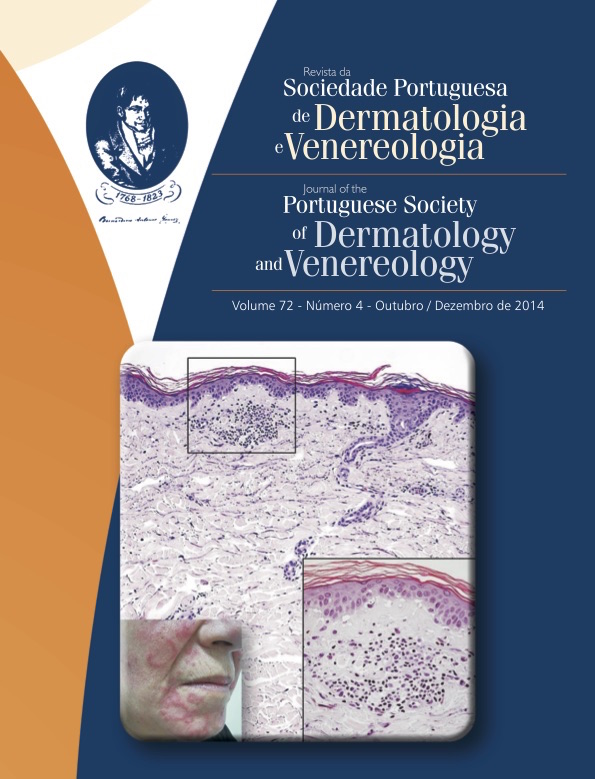OCCUPATIONAL ALLERGIC CONTACT DERMATITIS TO MERCAPTOBENZOTIAZOL
Abstract
Introduction: Allergic contact dermatitis to mercaptobenzothiazole and its derivatives has been increasingly recognized in industrialized countries because of their widespread use in polymerization of synthetic rubber. The authors describe two clinical cases with relevant occupational exposure.
Case reports: A 46 year-old male patient, with an eight month pruritic dermatitis, limited to the wrists, refractory to high potency topical corticosteroid and oral antihistamine. Physical examination showed erythematous-violaceous infiltrated plaques and excoriated erythematous papules on both wrists. Prick tests and RAST to latex were negative. Epicutaneous tests were performed with basic series from Portuguese Contact Dermatitis Group, rubber and glue series and fragments of the sleeve and it was found positivity for mercaptobenzothiazole (++), mercapto mix (++) and elastic band of gloves in reading at 72h and at 7 days. A 61 years old non atopic man, woodworker, with a 12- month history of itching, erythema, infiltration of genius region of face and extension to posterior cervical region.
Epicutaneous tests were performed with basic series from Portuguese Contact Dermatitis Group, rubber and glue series, cosmetics series and fragments of the protection mask work and it was found positivity for mercaptobenzothiazole (++), mercapto mix (++) and elastic band of mask (++) in reading at 72h and at 7 days.
Discussion: Despite being well known allergens, mercaptobenzothiazole and its derivatives may be present in other sources of exposure to rubber like elastic fabric in clothing. Once the worker sensitized, it can be an important cause of disability in an occupational and personnal setting.
Downloads
References
Adams A, Warshaw E. Allergic contact dermatitis from mercapto compounds. Dermatitis. 2006; 17(2):56-70.
Rudner EJ, Clendenning WE, Epstein E, et al. Epidemiology of Contact Dermatitis in North America:
Arch Dermatol.1973; 108(4):537-40.
North American Contact Dermatitis Group. Interim report 2003- 2004. Chicago: North American Contact Dermatitis Group; 2005.
Diepgen T, Bruynzeel D, Andersen K, Brandão F, Bruze M, Gonçalo M, et al. Mercaptobenzothiazole
or the mercapto-mix: which should be in standard series? Contact Dermatitis. 2006; 55(1):36-8.
Warshaw EM, Cook JW, Belsito DV, DeLeo VA, Fowler JF Jr, Maibach HI, et al. North American Contact
Dermatitis Group. Positive patch-test reactions to mixed dialkyl thioureas: cross-sectional data from the North American Contact Dermatitis Group, 1994 to 2004. Dermatitis. 2008; 19(4):190-201.
Storrrs F, Rosenthal LE, Adams RM, Clendenning W, Emmett EA, Fisher AA, et al. Prevalence and relevance of allergic reactions in patients tested in North America. J Am Acad Dermatol. 1989; 20(6):1038-44.
Nethercott JR, Holness DL, Adams RM, Belsito D, Deleo V, Emmett EA, et al. Patch testing with a routine screening tray in North America, 1985 through 1989: II. Gender and response. Am J Contact Dermat. 1991; 2:130-4.
Rietschel RL, Mathias CGT, Fowler JF, Pratt M, Taylor JS, Sherertz EF, et al. Relationship of occupation
to contact dermatitis: evaluation in patients tested from 1998 to 2000. Am J Contact Dermat. 2002; 13(4):170-6.
Dickel H, Kuss O, Schmidt A, Diepgen TL. Occupational relevance of positive standard patch-test
results in employed persons with an initial report of an occupational skin disease. Int Arch Occup Environ Health 2002; 75(6):423-34.
Nettis E, Marcandrea MC, Paradiso MT, Paradiso MT, Ferrannini A, Tursi A. Results of standard series
patch testing in patients with occupational allergic contact dermatitis. Allergy. 2003; 58(12): 1304-7.
Belsito DV. The immunologic basis of patch testing. J Am Acad Dermatol. 1989; 21 (4 Pt 2): 822-9.
Rietschel RL, Fowler JF .The pathogenesis of allergic contact hypersensitivity. 5th ed, Philadelphia: Lippincott Williams & Wilkins; 2001.
Wang X, Tabor MW. Studies of the reactivity of morpholine, 2-mercaptobenzothiazole and 2 of their
derivatives. Contact Dermatitis. 1988; 19(1):16-21.
All articles in this journal are Open Access under the Creative Commons Attribution-NonCommercial 4.0 International License (CC BY-NC 4.0).








